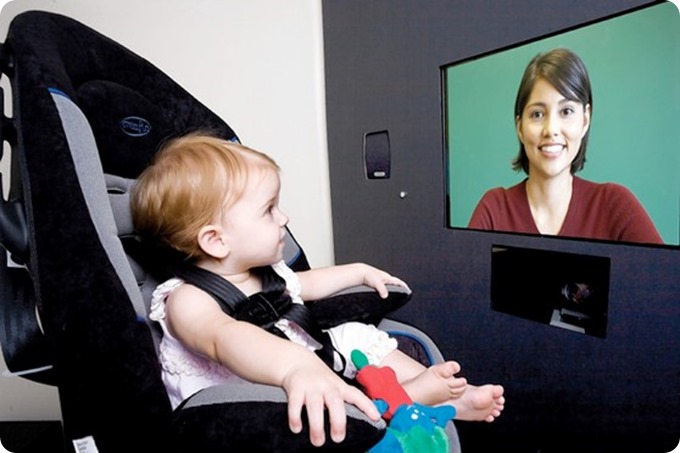Reduced eye contact is one of the hallmark symptoms of autism and often one of the earliest red flags for parents and physicians. The reason why has been a longstanding debate in the field.
Our study aimed to answer that question- why do young children with autism tend to make less eye contact?
We wanted to figure out the correct explanation to make sure that treatments can target the right underlying concern.

Image courtesy of Marcus Autism Center
What are the main hypotheses as to the underlying mechanism behind the avoidance of eye contact?
Two different explanations have been proposed to explain why children with autism look less at other people’s eyes.
One explanation is that children with autism avoid eye contact because they find it stressful and negative.
The other is that children with autism look less because the social cues from others’ eyes aren’t perceived as especially meaningful or important.
How much evidence is there for each hypothesis and why have researchers long debated this issue?
The existing evidence for and against each of the two explanations has been mixed, which I think explains why the debate has persisted.
One key is that most past research exploring the reason for reduced eye contact in autism has focused on older children and adults.
In this study, we wanted to look earlier in development, when symptoms of autism are first apparent and before compensatory or learned responses may emerge.
What did your recent research involve and how did you try to test these hypotheses? What were your main findings?
To test the two different explanations for why young children with autism tend to make less eye contact, we studied how 2-year-olds with and without autism paid attention to other people’s eyes using eye-tracking technology developed at the Marcus Autism Center.
Children watched a series of carefully made videos. Before each video, we flashed a small picture to draw the child’s attention. When they looked to where the picture had been, they found that they were either looking right at another person’s eyes or looking away from the eyes.
When we did this repeatedly, we found that young children with autism continued to look right at the eyes. Just like children without autism, they didn’t look away from the eyes or try to avoid the eyes in any way.
It was when we presented varying levels of socially meaningful eye contact that children with autism looked less at other people’s eyes.
Together, these findings went against the idea that these young children with autism were avoiding eye contact on purpose or had an aversion to eye contact. Instead, they seemed to not understand or pick up on the underlying social cues and social significance of eye contact.
What impact do you think this research will have?
What our findings suggest, especially for young children with autism, is that treatments will likely be most effective by trying to help children with autism learn to engage socially with other people.
Rather than just focusing on paying attention to others’ eyes, treatment can help make social interaction more meaningful in order to make social signals like eye contact less confusing.
Is it possible that the underlying reason could differ between children with autism, i.e. some children avoid eye contact as they are uninterested and others as they find it unpleasant?
It’s important to note that the research study tells us about autism as a whole. Every child with autism, just like every child without autism, is unique.
We found that young children with autism as a group do not actively avoid eye contact and instead miss the importance and significance of social information conveyed by eye contact.
At an individual level, treatments should always be tailored to each child’s unique strengths and weaknesses.
Could the reason for reduced eye contact change with age?
In this study, we wanted to focus early in development to understand the reason for reduced eye contact in autism close to when the symptoms are first apparent.
We were actually looking at eye gaze responses in a group of young children with autism on the day they were diagnosed. At these early ages, children weren’t averse to eye contact and didn’t avoid eye contact.
At older ages, some children and adults with autism have described feelings of anxiety when asked to make eye contact. I want to emphasize that the results of the study do not and are not meant to contradict any personal experiences. Those personal experiences are absolutely valid and provide an important source of information.
It gives us the opportunity to understand what might have changed between early ages, like in this study, and those later personal experiences, as children with autism may repeatedly be presented with social cues that seem confusing.
What further research is needed to further understand reduced eye contact in autism?
This study helped tell us about why children with autism make less eye contact. The next step is to understand more about how the brain becomes specialized for social interaction so that social interaction is rewarding and reinforcing to typically developing children.
From there, we can look into what may be different in brain development in autism. Our results implicate certain areas of the brain for future study.
Another important next step is to refine and increase the availability of early interventions and later treatments for autism that focus on increasing understanding of social information and improving social engagement.
Where can readers find more information?
The study was published in The American Journal of Psychiatry and can be accessed at http://dx.doi.org/10.1176/appi.ajp.2016.15091222.
To find out more about ongoing research studies at the Marcus Autism Center, please contact Beth Asher at [email protected] or +1-404-785-9473.
About Jennifer Moriuchi and Dr Warren Jones

Jennifer Moriuchi is a doctoral candidate in clinical psychology at Emory University and the Marcus Autism Center.
She is completing her clinical training at Oregon Health & Science University. Her research has been funded by the Autism Science Foundation.
 Dr. Jones received his doctorate in biomedical sciences from Yale University. From 2000 to 2003, he worked at the Yale Child Study Center with Ami Klin, Ph.D. During his time at Yale, Dr. Jones used eye-tracking technology to map visual salience young children children with autism, as they view movies of social interaction.
Dr. Jones received his doctorate in biomedical sciences from Yale University. From 2000 to 2003, he worked at the Yale Child Study Center with Ami Klin, Ph.D. During his time at Yale, Dr. Jones used eye-tracking technology to map visual salience young children children with autism, as they view movies of social interaction.
In a lab setting, Jones uses concealed cameras that zoom in on children's eyes and monitor the movement of their pupils to determine exactly what they are viewing on the TV screen. In 2006, Dr. Jones was awarded the American Psychological Foundation Elizabeth Munsterberg Koppitz Award for his work with eye-tracking technology.
Currently Dr. Jones is adapting this technology to be used in pediatricians' offices throughout Georgia, with the hopes of screen children earlier than previously thought possible.